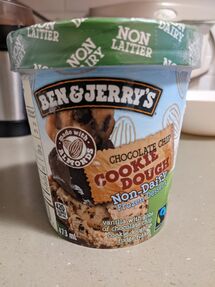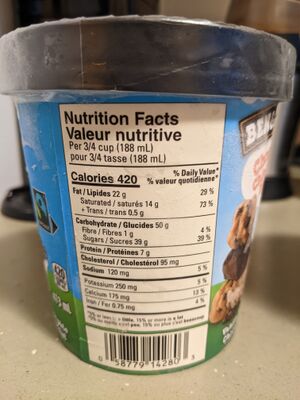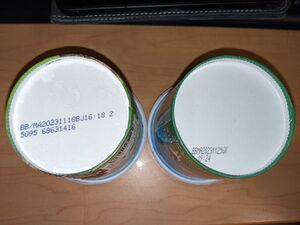Course:FNH200/Assignments/2022/Ben and Jerry's Ice Cream - Regular vs Non-Diary
Introduction
Ben and Jerry's is a popular brand known for their premium ice creams. They have a recipe for a rich, creamy, and delicious dessert that they have created a household name for themselves. Since starting in 1978, new flavours have been developed and are still being sold in the little tubs that we know and love. Their variety of flavours have quickly developed into fan favourites such as Half-Baked, Chunky Monkey, and Chocolate Chip Cookie Dough, which is the flavour that will be explored on this page. In 2016, Ben and Jerry's released their new non-dairy ice cream line that included some of the public's favourites. [1]
Photos of Products



Ingredient Lists
1. Ingredients
| Ben & Jerry's Chocolate Chip Cookie Dough Regular | Ben & Jerry's Chocolate Chip Cookie Dough Non-Dairy |
|
|


2. Substitutes and Food Additives
| Fat substitute, Sugar substitute & Food Additive | |
|---|---|
| Ben & Jerry Chocolate Chip Cookie Dough Ice Cream Regular | Fat substitute: N/A
|
| Ben & Jerry Chocolate Chip Cookie Dough Ice Cream Non-Dairy | Fat substitute: N/A
|
3. Role of Substitutes & Additives
Ben & Jerry's Chocolate Chip Cookie Dough Ice Cream Regular
Fat Substitutes: N/A


Sugar Substitutes: N/A
Additives:
- Natural flavour: Natural flavours are food additives that are used to enhance the flavour of various foods, such as cereals, herbal teas, and granola bars. [2] To claim ingredients or food products to have "natural flavours," the ingredients must not have been "subjected to processes that have significantly altered their physical, chemical or biological state"; however, the guidance for companies is flexible [3]. Ben & Jerry's did not specify the natural flavours added to their ice cream.
- Guar gum: Guar gum, a polysaccharide originally from guar gum beans, is an additive used in powdered form to stabilize, emulsify, and thicken the texture of various foods such as yogurts, soups, ice cream, and almond milk. [4] The beans produce an endosperm that produces the various polysaccharides such as galactomannans, mannose, and galactose and can be combined with water to produce a gel-like texture. Guar gum contains up to 8x more thickening strength than cornstarch and imparts the "mouth feel" flavour of ice cream. Additionally, guar stabilizes the emulsion by suspending water droplets in the mixture to prevent the fusion of water droplets into larger crystals when ice cream is frozen and refrozen multiple times. [5] Guar's effects are stronger in cold foods such as ice cream, while xanthan is better in baked goods. [6]
- Soy lecithin: Lecithin is an additive commonly found in foods such as egg yolk, sunflower, soybeans, milk, fish and animal fat by separating the gum from the oil . [7] It is an emulsifier composed of phospholipids giving both hydrophilic and lipophilic properties that allow lecithin to enhance the dispersion of water within the ice cream and give a smoother texture. [8]
- Carrageenan: Carrageenan is a polysaccharide additive extracted from red algae seaweed. They are commonly used as a thickening, gelling and emulsifying agent in foods. In Ben & Jerry's ice cream, they also act as a stabilizer to inhibit the growth of ice crystals that may form during distributions when the temperature could frequently change. [9]
Ben & Jerry's Chocolate Chip Cookie Dough Ice Cream Non-Dairy
Fat Substitutes: N/A
Sugar Substitutes:
- Corn Syrup Solid: Corn syrup is a sugar-based sweetener made by the hydrolysis of starch into saccharides such as maltose and glucose [10]. In ice cream, sugar bonds with the water molecules, which decreases the amount of free water. As more water freezes to ice, the sugar concentration increases, which decreases the freezing point and makes water less likely to harden when frozen. The end result is that the ice cream is softer. [10] The combination of glucose and maltose in corn syrup further decreases the possibility of crystallization and coarse texture by absorbing substantial amounts of water in the ice cream to make it smooth and moist. [10][11]
Additives:
- Natural flavour: Natural flavours are food additives that are used to enhance the flavour of various foods, such as cereals, herbal teas, and granola bars. [2] To claim ingredients or food products to have "natural flavours," the ingredients must not have been "subjected to processes that have significantly altered their physical, chemical or biological state"; however, the guidance for companies is flexible [3]. Ben & Jerry's did not specify the natural flavours added to the non-dairy ice cream.
- Colour: Colours are food additives that are typically incorporated into frozen desserts such as ice cream to enhance the visual appeal of the food and must match the flavour of the ice cream. [12] Colours can be lightened by increasing the number of particles that reflect light, which can be done by: decreasing air bubble size, increasing levels of casein micelles, decreasing fat globule size, and decreasing temperature treatment of ingredients. [12] The colour of the ingredients themselves such as brown for chocolate or pink for strawberry will also affect the overall colour. Additionally, natural vs artificial colours will affect the shelf-life of the additives, which will also factor into the appeal of the ice cream. [12] The Ben & Jerry's Ice Cream Non-Dairy does not specify the exact colour additives used.
- Guar gum: Guar gum, a polysaccharide originally from guar gum beans, is an additive used in powdered form to stabilize, emulsify, and thicken the texture of various foods such as yogurts, soups, ice cream, and almond milk. [4] The beans produce an endosperm that produces the various polysaccharides such as galactomannans, mannose, and galactose and can be combined with water to produce a gel-like texture. Guar gum contains up to 8x more thickening strength than cornstarch and imparts the "mouth feel" flavour of ice cream. Additionally, guar stabilizes the emulsion by suspending water droplets in the mixture to prevent the fusion of water droplets into larger crystals when ice cream is frozen and refrozen multiple times. [5] Guar's effects are stronger in cold foods such as ice cream, while xanthan is better in baked goods. [6]
- Lecithin (Soy and Sunflower): Lecithin is an additive commonly found in foods such as egg yolk, sunflower, soybeans, milk, fish and animal fat by separating the gum from the oil. [7] It is an emulsifier composed of phospholipids giving both hydrophilic and lipophilic properties that allow lecithin to enhance the dispersion of water within the ice cream and give a smoother texture. [8] Two sources of lecithin, sunflower and soy, were used in this particular Ben & Jerry's Ice Cream Non-Dairy to make this ice cream very smooth to emulate the consistency of its dairy counterpart.
- Pea protein: Pea protein is an additive that has increased in use for non-dairy ice cream over the past twenty years. [13] Pea protein has emulsifying, gelatinizing, and thickening properties in ice cream. Pea protein's high water-binding capacity allows it to emulsify water droplets to improve the stability and texture of the ice cream, as well as decrease the chance of large crystals from forming to cause coarseness. [14]
4. Compare and Contrast
Similarity: natural flavour, guar gum, soy lecithin
Differences: Water is added as a liquid in the non-dairy ice cream to replace condensed skim milk and cream. Corn syrup solid is used as a sugar substitute in the non-dairy to act as a bonding agent (stabilizer) for water and to enhance texture. Pea protein is added in the non-dairy as an emulsifier to replace the egg yolk used in the dairy counterpart. Sunflower lecithin is added in the non-dairy in addition to soy to enhance the texture and consistency. Colouring additive is also added in the non-dairy ice cream to enhance the visual appeal that may have been compromised due to the absence of dairy products.
Labels
| Required Labeling | Regular | Non-Dairy | Notes |
|---|---|---|---|
| Bilingual Labeling | Compile | Compile | Both contain English and French as they are imported to Toronto from the US |
| Common Name of the Food | Compile | Compile | They are both made from Ben and Jerry's and are specified by their flavour names |
| Country of Origin | Not Compile | Compile | They both show where they have been imported from but the regular does not mention its country of origin |
| Data Marking & Storage Instruction | Compile | Compile | Products are required to keep frozen.
Best before dates are printed at the bottom, as seen in Image 7. |
| Identity and Principal Place of Business | Compile | Compile | The principle place of business is in Vermont, United States
Canada imports the products to Toronto |
| Irradiated Foods | Not Compile | Not Compile | These products have not been irradiated so it is not required for labelling |
| Legibility and Location | Compile | Compile | Information is printed in clear, bolded text and can be found in many local grocery stores |
| List of Ingredients | Compile | Compile | Ingredients are shown in Image 3 and Image 4 |
| Nutrition Facts Table | Compile | Compile | Nutritional fact tables are shown in Image 5 and Image 6 |
| Net Quantity of the Food | Compile | Compile | Net quantity is 473mL for both products and can be seen in the front label (Images 1 and 2) |
| Sweeteners | Compile | Compile | Sweeteners are labelled in the ingredients lists |
| Nutrient Content Claims & Diet-Related Health Claims | Compile | Compile | There are no particular health claims about the product. However, they do have a mission statement to ensure that they are practicing sustainability in their food production. They promise to create quality products while being conscious of the environment in their sourcing with Fairtrade[15] |
| Milk Fat (>= 8%) | Not Compile | N/A | Does not explicitly mention the percentage of milk fat in ingredients of the dairy product |
| Serving Size | Compile | Compile | Mentioned in the front label and in the nutrition facts table for 420 calories per 188mL |
| Grade Name | Not Compile | Not Compile | No particular grade name but does mention mass balance in both products as required by Fairtrade sourcing |
References
- ↑ "EXCLUSIVE BEN & JERRY'S NEWS!". Vegconomist. February 12, 2019. Retrieved July 18, 2022.
- ↑ 2.0 2.1 Kay, Stephanie (August 15 2019). "What is natural flavour?". Stephanie Kay Nutrition. Retrieved July 17 2022. Check date values in:
|access-date=, |date=(help) - ↑ 3.0 3.1 "Method of production claims on food labels". Canadian Food Inspection Agency. Retrieved July 17 2022. Check date values in:
|access-date=(help) - ↑ 4.0 4.1 Levy, Jilian (November 18 2019). "Guar Gum: Is This Food Additive Harmful or Helpful?". Dr. Axe Co-Founder of Ancient Nutrition. Retrieved July 17 2022. Check date values in:
|access-date=, |date=(help) - ↑ 5.0 5.1 "How to use stabilizers in ice cream". Dream Scoops. Retrieved July 17 2022. Check date values in:
|access-date=(help) - ↑ 6.0 6.1 Levy, Jillian (November 18 2019). "Guar Gum: Is This Food Additive Harmful or Helpful?". Dr. Axe Co-Founder of Ancient Nutrition. Retrieved July 17 2022. Check date values in:
|access-date=, |date=(help) - ↑ 7.0 7.1 "Sunflower lecithin vs Soy Lecithin: What's the Difference". National Lecithin. July 14 2021. Retrieved July 17 2022. Check date values in:
|access-date=, |date=(help) - ↑ 8.0 8.1 Crowley, Michelle (March 7 2022). "Difference Between Soy Lecithin and Sunflower Lecithin". Difference Between. Retrieved July 17 2022. Check date values in:
|access-date=, |date=(help) - ↑ "Dear Ben & Jerry's, Why Is There Seaweed In My Ice Cream?".
- ↑ 10.0 10.1 10.2 Ruben (December 12 2017). "Why is Corn Syrup Used in Ice Cream?". Ice Cream Science. Retrieved July 17 2022. Check date values in:
|access-date=, |date=(help) - ↑ "The importance of sugar in ice cream". Dream Scoops. Retrieved July 17 2022. Check date values in:
|access-date=(help) - ↑ 12.0 12.1 12.2 Tharp, Bruce; Young, Steve (May 1 2011). "Factors Affecting Colour in Ice Cream". Dairy Foods. Retrieved July 17 2022. Check date values in:
|access-date=, |date=(help) - ↑ Guler-Akin, Mutlu; Avkan, Firdevs; Akin, Musa (august 25 5021). "A novel functional reduced fat ice cream produced with pea protein isolate instead of milk powder". Journal of food Processing and Preservation. 45: 15901 – via Institute of Food Science and Technology. Check date values in:
|date=(help) - ↑ Sandberg, A (March 27 2014). "Developing functional ingredients: a case study of pea protein". Woodhead Publishing Series in Food Science, Technology, and Nutrition: 358–382 – via ScienceDirect. Check date values in:
|date=(help) - ↑ Chiffey, Maddy. "Ben and Jerry's Mission Statement Explained: In-Depth Analysis". Business Chronicler. Retrieved July 18, 2022.
| This Food Science resource was created by Course:FNH200. |
